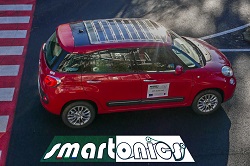Highly efficient production technologies to take over the OE market
The SMARTONICS project had the ambition to make the European organic electronics and photonics industry more competitive by allowing it to meet future market demands. Led by the Aristotle University of Thessaloniki in Greece, it consisted in the development of smart nanomaterials and precision sensing and fabrication tools, as well as their integration into three unique pilot lines based on Roll-to-Roll (R2R) printing, Sheet-to-Sheet (S2S) printing and Organic Vapour Phase Deposition (OVPD). ‘SMARTONICS achieved the pilot production of organic photovoltaic materials (OPVs) with high efficiency and lifetime,’ says Prof Stergios Logothetidis, coordinator of the project. ‘This was made possible through to the use of polymer-based organic semiconductors, “super-barrier” nanomaterials for encapsulation, and plasmonic metallic nanoparticles produced with laser processes allowing greater control over sizes and distributions. Moreover, our advances in multiscale computational modelling and simulation contribute significantly to optimising OPV and OLED device architecture as well as their nano-layer morphology’. Demonstrated S2S OPV cells boast an 8 % efficiency, R2R OPV cells reach 5.3 %, and fully-printed R2R OPV panels score at 3.5 %. These OPVs have a lifetime superior to five years and have been successfully integrated in automotive applications, including a solar roof for the Fiat 500L. But the contribution of SMARTONICS partners goes beyond these nanomaterials. In their three years of work, the team created a unique inline inkjet printer for the large-scale fabrication of OPV nano-layers using the R2R process; Organic Vapor Phase Deposition (OVPD) processes for the nanofabrication of small molecule-based tandem OPV devices; and a nanometer scale patterning enabling the large-scale fabrication of OPV devices interconnected into large-scale modules. Finally, they came up with novel optical metrology tools and methodologies for R2R printing and OVPD pilot lines, to monitor the quality and thickness of OPV nanomaterials and devices in single, inverted and tandem architectures. SMARTONICS is expected to have a significant impact on the OE market, enabling the production of large volumes at low cost. It will enable the production of tailored polymer organic semiconductors and plasmonic nanoparticles for the likes of OPVs, OLEDs, OTFTs, sensors and functional surfaces; whilst the ‘super barriers’ will address the market’s need for cost-effective and highly efficient encapsulation of OE devices and other products like food and pharmaceuticals. ‘Our optical metrology tools will boost the quality of OE devices, leading to the increase of the process yield and manufacturing throughput, as well as the reduction of fabrication costs,’ Prof Logothetidis also notes. Besides the automotive industry, potential applications include large scale energy-harvesting OPV panels for buildings, smart wearables, indoor applications, as well as OLEDs for displays and lighting. ‘We have very exciting prospects,’ says Prof Logothetidis. ‘For example, we have already been contacted by potential customers in the EU, Japan and South Korea to jointly manufacture advanced device architectures powered by in-line optical control and laser patterning. Moreover, we are discussing with potential customers for the application of our OPVs panels on Mediterranean greenhouses.’ SMARTONICS pilot lines have already become a global reference in the smart fabrication and encapsulation of a huge variety of nanomaterials, devices and functional components. And the consortium hopes it will stay that way: ‘Besides increasing process reliability, manufacturability of OE devices and using them for prototyping and field testing, we are planning on offering a one-stop-shop concept for EU companies, SMEs and other interested entities to explore novel concepts and to implement OE functionalities in their innovative products through an open access framework,’ Prof Logothetidis enthuses. ‘Our pilot lines will be also connected with others to create the critical mass that will boost Europe’s industrial leadership in Smart Manufacturing.’







